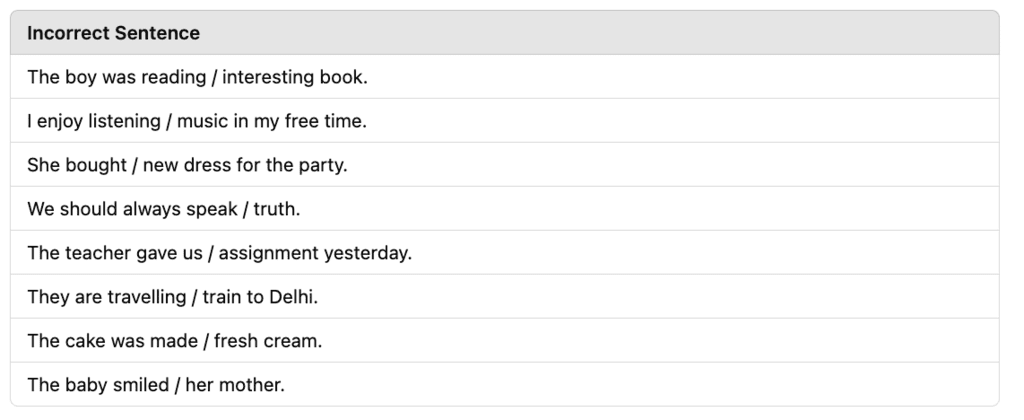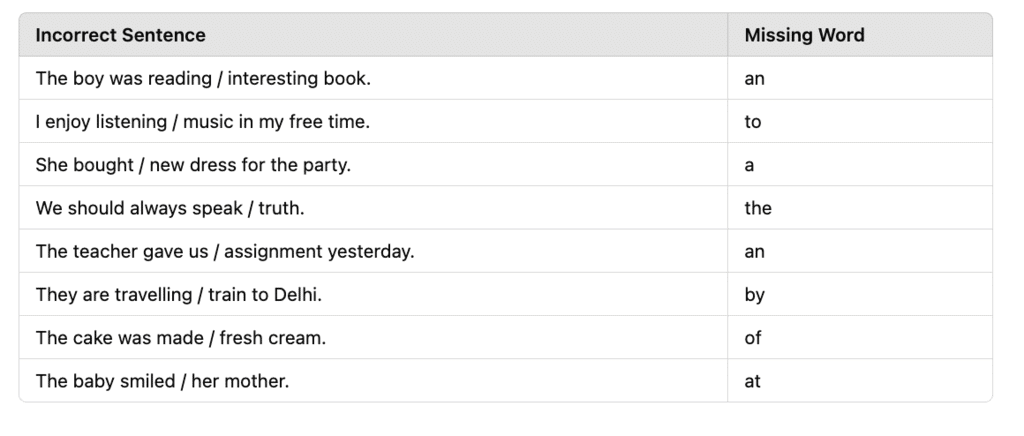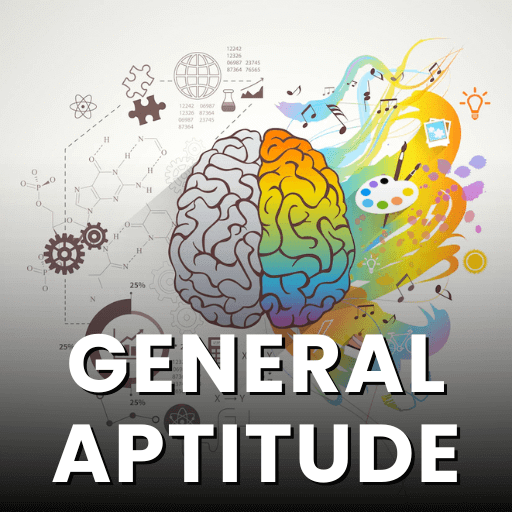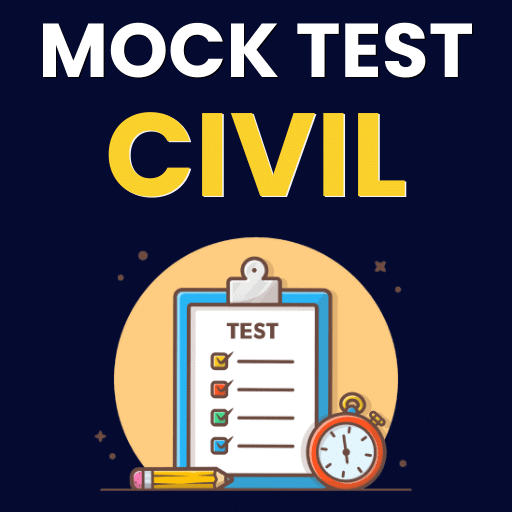Sample Question Paper Solutions(Set-4) | Sample Papers For Class 6 PDF Download
| Table of contents |

|
| Section A (Reading) |

|
| Section B (Writing) |

|
| Section C (Grammar) |

|
| Section D (Literature) |

|
General Instructions :
1. This paper consists of 4 sections :
- Section A: Reading: 20 marks
- Section B: Writing: 25 marks
- Section C: Grammar: 20 marks
- Section D: Literature: 25 marks
2. Attempt all the questions.
3. All the answers must be correctly numbered as in the question paper and answered in the answer sheet.
4. Ensure that questions for each section are answered together.
5. Read each question carefully and follow the instructions.
Section A (Reading)
Q1: Read the passage and answer the questions given below: [2 × 5 = 10 Marks]
The Life of Marie Curie
Marie Curie, born in 1867 in Warsaw, Poland, is one of the most renowned scientists in history. She is best known for her groundbreaking research on radioactivity, a term that she herself coined. Curie was the first woman to win a Nobel Prize and the only person to win Nobel Prizes in two different scientific fields—Physics in 1903 and Chemistry in 1911. Her work led to the discovery of two elements, polonium and radium, which had significant impacts on the development of radiation therapy in cancer treatment. Despite facing challenges as a woman in the male-dominated field of science, Curie remained dedicated to her research and made lasting contributions to both physics and chemistry. Her pioneering efforts paved the way for future advancements in medicine and science, making her an inspiration to generations of scientists worldwide.
(i) What is Marie Curie best known for?
(a) Her work in literature
(b) Her discovery of electricity
(c) Her research on radioactivity
(d) Her study of astronomy
Ans: (c)
Sol: Marie Curie is best known for her pioneering research on radioactivity, which significantly impacted the scientific world and led to many future discoveries.
(ii) What was the significance of Marie Curie winning two Nobel Prizes?
(a) She was the first person to win a Nobel Prize in Chemistry.
(b) She became the only person to win Nobel Prizes in two different scientific fields.
(c) She was recognized for her contributions to medicine alone.
(d) Her work was not recognized by the scientific community.
Ans: (b)
Sol: Marie Curie is the only person to have won Nobel Prizes in two different fields—Physics and Chemistry—making her achievements extraordinary and unique in the scientific world.
(iii) What does the word "groundbreaking" mean in the context of the passage?
(a) Traditional and well-established
(b) Very old and outdated
(c) New and innovative
(d) Easily understandable
Ans: (c)
Sol: The word "groundbreaking" in the passage refers to Marie Curie's innovative and pioneering work in the field of radioactivity, which opened up new areas of scientific research.
(iv) How did Marie Curie contribute to cancer treatment?
(a) By discovering a new drug
(b) By developing radiation therapy
(c) By promoting surgical procedures
(d) By studying mental health
Ans: (b)
Sol: Marie Curie's discovery of polonium and radium led to the development of radiation therapy, which has since been used as a treatment for cancer.
(v) Which two elements did Marie Curie discover?
(a) Hydrogen and oxygen
(b) Polonium and radium
(c) Carbon and nitrogen
(d) Uranium and platinum
Ans: (b)
Sol: Marie Curie discovered two elements—polonium and radium—during her research on radioactivity, which contributed significantly to the advancement of science and medicine.
Q2: Read the beautiful poem and answer the questions given below: [2 × 5 = 10 Marks]
A little cloud floated up so high,
Drifting slowly across the sky.
It was white and fluffy, light as air,
Moving gently without a care.
It passed by trees and buildings tall,
And waved goodbye to the sun’s bright call.
The wind whispered, “Go on, don’t stay,”
So the cloud drifted further away.
As it sailed through the afternoon blue,
I watched it change its shape, it grew.
From a bunny to a ship, then a crown,
The little cloud floated slowly down.
(i) The poem is talking about a
(a) cloud
(b) bird
(c) car
(d) tree
Ans: (a)
Sol: The poem describes the journey of a little cloud floating across the sky.
(ii) What color was the cloud?
(a) Blue
(b) White
(c) Grey
(d) Yellow
Ans: (b)
Sol: The poem describes the cloud as white and fluffy.
(iii) What did the cloud pass by?
(a) A mountain
(b) Trees and buildings
(c) A river
(d) A desert
Ans: (b)
Sol: The cloud passed by trees and tall buildings, as mentioned in the poem.
(iv) What did the cloud change into?
(a) A rainbow
(b) A ship and a bunny
(c) A bird
(d) A flower
Ans: (b)
Sol: The cloud changed its shape into a bunny, ship, and then a crown.
(v) A pair of rhyming words is
(a) air-care
(b) sky-high
(c) sun-run
(d) cloud-ship
Ans: (a)
Sol: "Air" and "care" rhyme in the poem.
Q3: Read the passage and answer the questions given below: [2 × 5 = 10 Marks]
In a small village by the river, there lived a young boy named Rahul. Rahul was known for his curiosity and love for exploring nature. Every morning, he would wander through the fields, examining the plants and watching the animals. One day, while walking along the riverbank, he noticed something strange. There was a large rock sticking out of the water that he had never seen before. Intrigued, Rahul decided to get a closer look.
As he approached the rock, he saw that it was covered with moss and small plants growing on it. Upon further inspection, he noticed that the rock had some unusual markings. They seemed to be ancient symbols, and Rahul wondered what they meant. Determined to find out, he spent the next few days visiting the rock, observing it closely, and taking notes.
One afternoon, while Rahul was sitting by the rock, an old man passed by. The man noticed Rahul and sat down next to him. "What are you doing here, young boy?" the old man asked. Rahul explained his discovery and showed the man the markings on the rock. The old man smiled and said, "Those symbols are from an ancient time. They tell the story of the first settlers who lived by this river. If you study them carefully, you will learn much about the past."
Rahul was excited by the idea of learning more. He spent the next few weeks studying the markings with the old man, and together, they uncovered the history of the village and its people. Rahul realized that sometimes the most interesting discoveries are hidden in plain sight, and they only need a curious mind to uncover them.
(i) What did Rahul love to do?
Ans: Rahul loved to explore nature and examine plants and animals.
(ii) What did Rahul find by the river one day?
Ans: Rahul found a large rock sticking out of the water that had unusual markings on it.
(iii) What did the old man tell Rahul about the markings on the rock?
Ans: The old man told Rahul that the markings were ancient symbols that told the story of the first settlers who lived by the river.
(iv) Write whether the statements are ‘True’ or ‘False’.
(a) Rahul found the rock while walking through the fields.
(b) The rock had no markings on it.
(c) The old man was knowledgeable about the markings.
(d) Rahul ignored the old man's advice.
Ans:
(a) False (He found it by the river.)
(b) False (The rock had unusual markings.)
(c) True
(d) False (Rahul eagerly studied the markings with the old man.)
(v) How did Rahul feel after talking to the old man?
Ans: Rahul felt excited and eager to learn more about the markings and the history of the village.
(vi) What lesson did Rahul learn from his discovery?
Ans: Rahul learned that sometimes interesting discoveries are hidden in plain sight, and curiosity can help uncover the past and reveal important knowledge.
(vii) Write the opposites of:
(a) young _______
(b) hidden _______
Ans:
(a) old
(b) visible
(viii) Summarize the key message of the passage.
Ans: The key message of the passage is that curiosity and attention to detail can lead to valuable discoveries, and sometimes the most important lessons are found in the simplest things around us.
Section B (Writing)
Q4: Write an application to the principal asking for permission to arrange a trip. [10 marks]
Ans:
18 March, 20XX
The Principal,
Cambridge School
Lucknow
Subject: Permission to arrange a trip
Sir,
I, on behalf of the students of Class VI, humbly request your permission to arrange a trip to Nainital during the summer vacation. Our class teacher, Ms. Reena Bansal, and English teacher, Ms. Arti Singh, have kindly consented to accompany us. Nainital, a beautiful hill station, offers opportunities for trekking and camping, which will be an enriching experience for all students. This trip will help us build confidence and foster teamwork. We request your approval to make all the necessary arrangements under your guidance.
Thank you for considering our request.Yours sincerely,
Radhika
(Class Representative)
Q5. Write a speech for the morning assembly on the topic ‘Commonwealth Games in Delhi’. [15 marks]
Ans: Commonwealth Games in Delhi
It’s an honour to stand before you today to share my thoughts on a remarkable event that brought India into the global spotlight—the 2010 Commonwealth Games hosted by our very own capital, Delhi.
In 2010, Delhi had the proud privilege of hosting the Commonwealth Games, marking it as the biggest multi-sport event ever held in India. A total of seventy-two nations participated, competing for medals in seventeen different games. The Indian government made tremendous efforts to ensure the success of the event, investing significant resources in building state-of-the-art infrastructure. Special 'Games Villages' were set up across the city, and our stadiums were revamped to meet international standards. In addition, several cleaning and beautification drives were carried out to enhance the city's appeal and ensure a welcoming atmosphere for athletes and visitors.
Thanks to these efforts, the Commonwealth Games turned out to be a resounding success! Not only did they contribute significantly to the economic development of our country, but they also strengthened India’s reputation on the world stage. These Games provided a major boost to sports and sports infrastructure in India, areas that had been struggling for attention until then.
In conclusion, the 2010 Commonwealth Games were not just an event—they were a turning point for India’s sporting culture and a symbol of our nation’s growth.
Thank you for your attention, and I appreciate your patience in listening.
Section C (Grammar)
Q6: In the following passage, one word was omitted from each line. A slash '/' has been inserted where the word is missing. Write the missing word. [½ × 8 = 4]
Ans:
Q7: The following lines has not been edited. There is one error in each line. Write incorrect word and correction alongwith: [1 × 5 = 5 Marks]
Ans:
Q8: Rearrange the jumbled words into a meaningful sentence. [½ × 2 = 1 Mark]
(a) important / it / to / eat / healthy / food.
(b) I / going / am / the / to / market / today.
Ans:
(a) It is important to eat healthy food.
(b) I am going to the market today.
Q9: Change the voice of the following sentences: [½ × 2 = 1 Mark]
(i) They play football every Sunday.
(ii) The chef cooked a delicious meal.
Ans:
(i) Football is played by them every Sunday.
(ii) A delicious meal was cooked by the chef.
Q10: Fill in the blanks with the correct form of the verbs given in the brackets: [½ × 2 = 1 Mark]
(i) While I __________ (walk) in the park, I __________ (meet) an old friend.
(ii) She __________ (not understand) the lesson. She __________ (ask) the teacher for help.
Ans:
(i) was walking, met
(ii) does not understand, asked
Q11: Do as directed. [8 Marks]
(a) Choose the correct verb and rewrite the sentences.
(i) The students (study/studies) hard for the exam.
Ans: The students study hard for the exam.
(ii) The flowers (bloom/blooms) in spring.
Ans: The flowers bloom in spring.
(b) Complete these questions using Have you ever... or Did you ever...?
(i) __________ visited a historical monument?
Ans: Have you ever visited a historical monument?
(ii) __________ try swimming in the sea?
Ans: Did you ever try swimming in the sea?
(c) Complete these words with ‘ei’ or ‘ie’.
(i) th___f
Ans: thief
(ii) for__gn
Ans: foreign
(iii) w___ght
Ans: weight
(iv) v___n
Ans: vein
(d) Form complex sentences by joining the two sentences with the help of conjunctions.
(i) He was hungry. He didn’t have time to eat. (although)
Ans: He was hungry, although he didn’t have time to eat.
(ii) She was excited about the trip. She couldn’t sleep. (because)
Ans: She was excited about the trip because she couldn’t sleep.
(e) Complete these sentences with correct collocations.
(i) Please __________ your shoes when you enter the house. (take / wear)
Ans: Please take your shoes when you enter the house.
(ii) She __________ a beautiful drawing for the competition. (made/did)
Ans: She made a beautiful drawing for the competition.
 |
Download the notes
Sample Question Paper Solutions(Set-4)
|
Download as PDF |
Section D (Literature)
Q12: Read the extract and choose the correct answer from the following: [1 x 3 = 3 marks]
Mr. Raven was perched upon a limb,
And Reynard the Fox looked up at him;
For the Raven held in his great big beak,
A morsel the Fox would go far to seek.
(i) Who was Mr. Raven and where was he?
(a) Mr. Raven was a lion and he was sitting on a rock.
(b) Mr. Raven was a crow and he was sitting on a branch of a tree.
(c) Mr. Raven was a sparrow and he was sitting on the ground.
(d) Mr. Raven was an eagle and he was sitting on a cliff.
Ans: (b)
(ii) What does a ‘limb’ stand for?
(a) A part of a bird’s body.
(b) A piece of wood used for furniture.
(c) A branch of a tree.
(d) A part of a human body.
Ans: (c)
(iii) In the phrase “big beak”, the letter b is repeated, which figure of speech is it?
(a) Simile
(b) Personification
(c) Alliteration
(d) Hyperbole
Ans: (c)
Q13: Read the extract and answer the following: [1 x 3 = 3 marks]
Subhodayam! I am Balamurali from Andhra Pradesh. I want to tell you about the 400-year-old art of making toys in my village, Kondapalli. To make the toys, we take soft wood from the nearby hills. After that, we carve each part of the toy separately. Then, we use makku—a paste of tamarind seed powder and sawdust to join the pieces together. Next, we add details and finish the toys. Finally, we use oil and watercolours or vegetable dyes and enamel paints to color them. These toys are based on folk stories, animals, birds, bullock carts, rural life, etc.
(A) How does Balamurali greet children and teachers of the school?
Ans: Balamurali greets children and teacher of the school by saying “Subhodayam!”.
(B) Which are the dyes used to color the toys?
Ans: Oil and water-colours or vegetable dyes and enamel paints are used to colour the toys.
(C) How old is the art of Kondapalli village?
Ans: The art of Kondapalli village is 400 years old.
Q14: Answer the following questions: [2 x 5 marks = 10 marks]
(i) What happened to the fields that were lying empty for years?
Ans: The fields that were lying empty for years were first cleaned, then according to the instruction of the sage, Rama Natha planted rows and rows of banana plants, and the large tracts of land turned into a huge plantation.
(ii) How did Prabhat look at games?
Ans: Prabhat looked at games differently. If he sensed that he would lose the game, he would not play it. Winning a game would give him a kind of unique feeling.
(iii) How did Ila overcome her physical challenge?
Ans: Despite being born with hands that couldn’t be used conventionally, Ila’s mother and grandmother, skilled in Kathiawar embroidery, taught her to embroider using her feet.
(iv) What would the fox go far to search?
Ans: The fox was eyeing the morsel that the Raven had in his beak. He wanted to get that morsel, if he did not, he would have to go far to find food.
(v) How is the Neem useful to the farmers?
Ans: Farmers use the powder of neem seeds to protect their crops from insects and locusts. They mix them with water and spray it on the crops of their fields. This also protects the roots of crops from the breeding of termites and mosquitoes.
Q15: Answer the following: [3 Marks]
Give the character sketch of Mario.
Ans: Mario was a friendly boy and loved to have lots of friends. He boasted of having many friends in his school and how he was so friendly with everyone. His grandfather was sure many of his friends were nothing more than companions or partners. He was also a brave and determined boy who took the challenge of his grandpa to know his real friends in the school.
Mario was also very obedient and trustworthy. He asked his grandfather to suggest some kind of test. He believed the story of the invisible chair because he knew that his grandfather had a vast experience. So, we can say he had respect for his elders too.
Q16: You have read the lesson ‘The Unlikely Friendship’. Now, express your views on the ‘Significance of Friendship’ in about 80-100 words. [6 Marks]
Ans: Friendship holds immense significance in our lives, as depicted in the story The Unlikely Friendship. True friendship provides emotional support and a sense of belonging. Gajaraj, despite receiving royal treatment, felt lonely until he found a friend. Their bond brought joy and they found happiness in it and they loved every activity they did together. Friendship overcomes differences.
Empathy, loyalty, and the importance of being there for one another make the friendship stronger.
‘Friendship is the hardest thing in the world to explain. It’s not something you learn in school. But if you haven’t learned the meaning of friendship, you really haven’t learned anything,’ said Muhammad Ali, the great champion. Friends are one of the greatest treasures in life so we must always cherish our friendship.
FAQs on Sample Question Paper Solutions(Set-4) - Sample Papers For Class 6
| 1. What are the main sections included in the Class 6 Sample Question Paper Set-4? |  |
| 2. How can I prepare effectively for the Class 6 Sample Question Paper? |  |
| 3. Are the questions in the Class 6 Sample Question Paper Set-4 aligned with the current curriculum? |  |
| 4. What types of questions can I expect in each section of the Sample Question Paper? |  |
| 5. How important is it to practice with sample question papers like Set-4 for Class 6 students? |  |





















